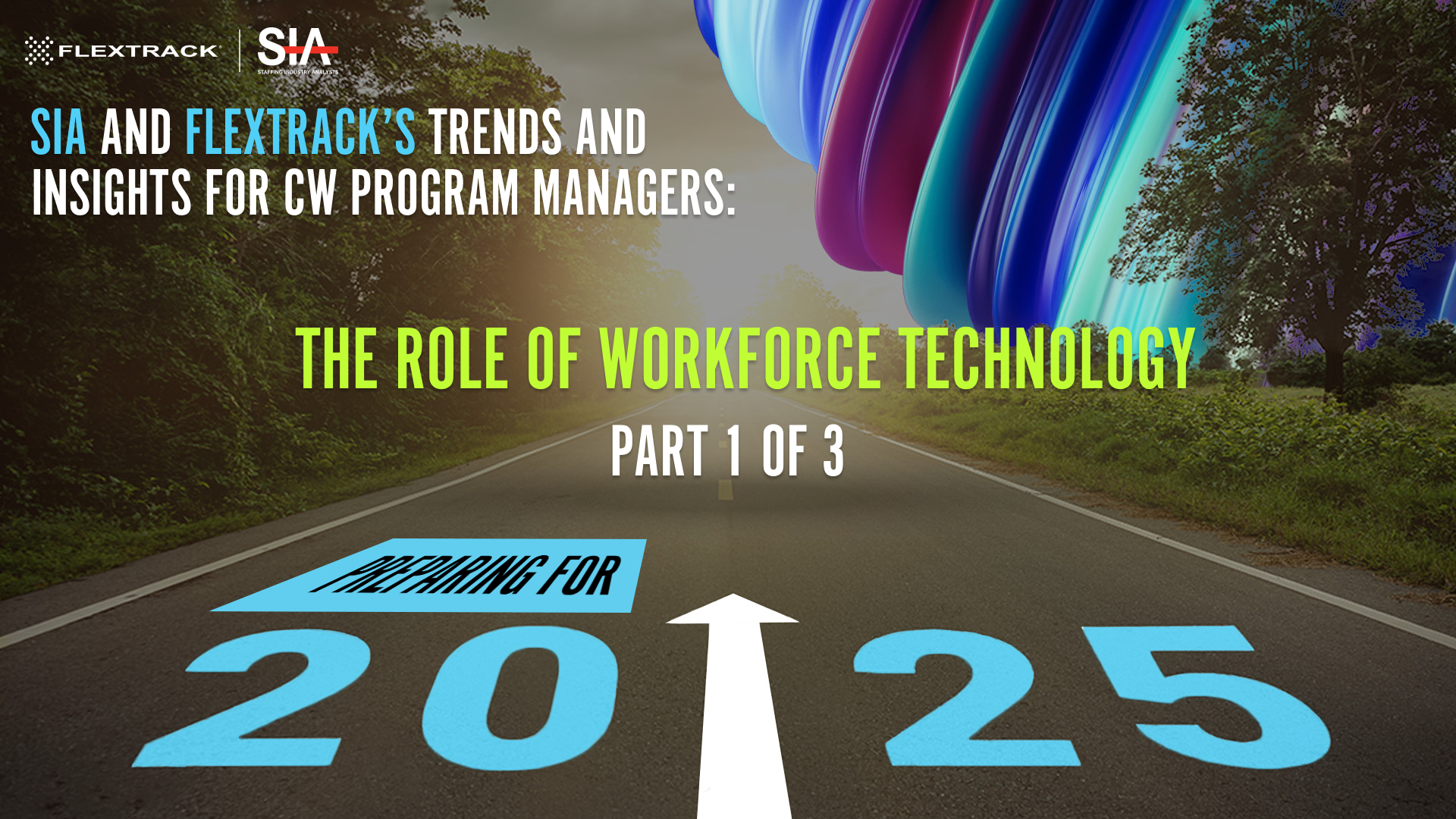
25 Feb SIA and Flextrack’s trends and insights for CW Program Managers: Part 1 of 3
The Role of Workforce Technology in 2025: Part 1 of 3
As contingent workforce managers and leaders step out of last year’s changes and challenges and into 2025, the focus is shifting to understanding what lies ahead and how to strategically prepare for this year’s demands.
This year, SIA partnered with Flextrack to bring the annual Staffing Industry Analyst’s CWS webinar, titled What CW Program Managers Need to Know in 2025. CWS Council Analysts came together to share predictions and discuss practical advice for contingent workforce program managers.
What you need to know in 2025 – Technology
Technology is rapidly reshaping how organizations manage their contingent workforce. From AI-driven automation to cybersecurity challenges, leaders and teams need more than just basic legacy tools. In 2025, those in the lead will embrace innovation, seamless integrations, and leverage data-driven decision-making that doesn’t shy away from AI, approaching it with caution and understanding.
Below you’ll find 10 key trends centered on technology discussed in SIA’s webinar. Dive into each to explore how they are shaping the future of contingent workforce management and how organizations like yours can utilize them to stay future-proof.
1. Tech Integrations
End-to-end visibility in a progressively complex world is critical for tracking spend, contracts, classifications, performance, compliance and so much more across multiple workforce channels as leaders are looking for a single source of truth to keep data reliable, accurate, and visible. It’s time to embrace data-driven decision-making and automation as these will give managers and teams a competitive edge through the use of tools like advanced analytics in optimizing efficiency and user experience. The results could be seen in cutting down administrative workloads and manual errors. The simplicity of a streamlined user experience is expected to dramatically boost user adoption and end-user satisfaction.
2. AI & Automation in CW Programs
AI and automation in the contingent workforce management space is exciting and starting to revolutionize how workforce programs are run. This technology has already started to significantly improve costs and efficiency as well as streamline legal and regulatory compliance through the automation process and will only continue to be more intertwined in everyday operations.
Workforce leaders and program managers can expect to see a big uptick in AI-driven analytics. Expect scalability and agility to become major priorities as organizations adapt to shifting market demands on a global scale.
3. AI Regulation
As AI becomes even further entrenched in the everyday of workforce management, we can expect greater regulatory scrutiny with stricter compliance requirements.
Leaders must ensure fair, transparent, and compliant AI to avoid risks related to bias, data privacy, and governance, which will become more talked about issues, especially in recruitment. With significant financial penalties for non-compliance, organizations must stay ahead of evolving laws and ethical AI best practices as legislation catches up to the developing capabilities of AI.
4. Top AI Risks for CW Programs
As AI adoption accelerates in the contingent workforce space, leaders must address data privacy and volume, security risks, and bias in hiring. Keeping an eye on European action around AI can be useful as program managers test and use new tools. Over-reliance on AI without human oversight can lead to unintended consequences and compliance risks.
Ensuring governance and transparency in AI decision-making will be critical in mitigating these risks.
5. Top Cyber Risks for CW Programs
Contingent workforce programs face increasing data protection risks, access control challenges, and remote work vulnerabilities. Without continuous monitoring, auditing, and strategies for quick response, organizations may struggle to protect sensitive worker data and intellectual property.
6. Supplier Re-Introduction/Education
The past year saw frequent supplier personnel changes, and there’s a possibility of this continuing into the year ahead – that means relationships need constant reevaluation and communication. Leaders should educate partners on processes, expectations, SLAs, and KPIs to maintain alignment and improve performance. In addition, prepare for new relationships through adjusting communication and setting expectations that may look different than what you’re used to.
7. Next generation MSP
Organizations are becoming more discerning and demanding, in response, MSPs must evolve to meet these client needs. From bespoke services and improved tech models, MSPs need to help their clients unlock value across the entire talent spectrum, focusing on omnichannel talent acquisition strategies and offering more sourcing flexibility beyond traditional staffing models.
A stronger focus on service will differentiate top providers, as organizations demand tailored solutions rather than one-size-fits-all approaches with a lean into partnership and a consultative approach. Modern differentiators, including AI-powered insights and ecosystem integrations, will be key to long-term success.
8. Higher Bill Rates on the Horizon
Workforce leaders should expect pay rate increases due to minimum wage increases, cost-of-living adjustments, and growing demand for top talent. The push for return-to-office mandates also introduces new expenses for workers, whose expectations will center around compensation.
9. CW Program Risk Management Priorities
As the industry rapidly changes, so do the risks that contingent workforce leaders need to be on the lookout for.
Key risk factors workforce leaders should have a proactive plan to navigate in 2025 include cybersecurity threats, responsible AI adoption and auditing, worker bill of rights compliance, pay transparency law changes, immigration policy shifts, and DEI&B practices and compliance.
10. Job Taxonomy: Aligning the Permanent & Contingent Workforce
Having a common job taxonomy has proven a challenge for many organizations, often involving significant external fees and consulting. Collaboration between HR and procurement can alleviate these pain points through improved consistency and accuracy.
With the growth of artificial intelligence capabilities, AI-powered job taxonomy creation is helping organizations build more consistent, accurate job classifications across permanent and contingent roles.
Discover what your future will look like with Flextrack
